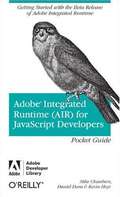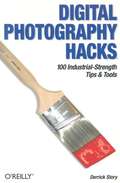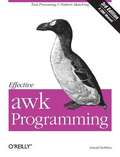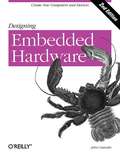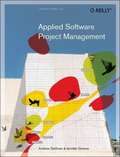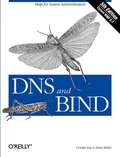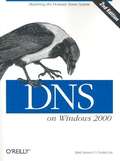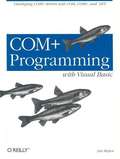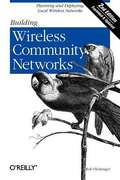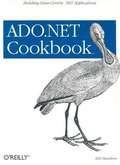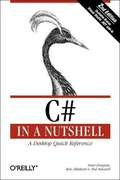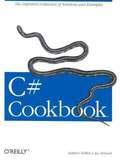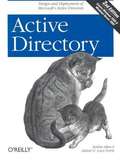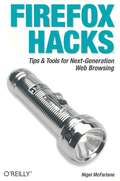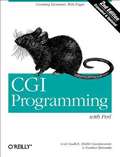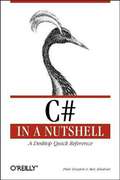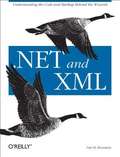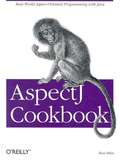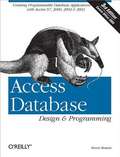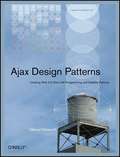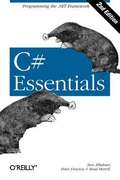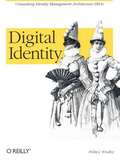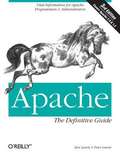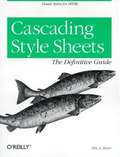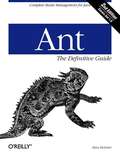- Table View
- List View
Adobe Integrated Runtime (AIR) for JavaScript Developers Pocket Guide
by Mike Chambers Daniel Dura Kevin HoytWritten by members of the Adobe Integrated Runtime (AIR) product team, this is the official guide to the beta release of Adobe's new cross-platform desktop runtime, previously known by its code name Apollo. This book explains how you can use AIR to build and deploy HTML and JavaScript-based web applications to the desktop, using all of the tools and technologies with which you are already familiar. Everything you need to know about this platform is right here, so you can start building applications with AIR right away. Topics include: What AIR is, and the problems this runtime aims to solve How to set up your development environment How to create your first app using HTML and JavaScript The HTML and JavaScript environments within AIR How to do common tasks, presented in the easy-to-use O'Reilly Cookbook format Also included is a guide to AIR packages, classes and command line tools. Once you understand the basics of building an HTML- and JavaScript-based AIR applications, this pocket guide makes an ideal reference for tackling specific problems. Welcome to the revolution! Adobe Developer Library is a co-publishing partnership between O'Reilly Media and Adobe Systems, Inc. and is designed to produce the number one information resources for developers who use Adobe technologies. Created in 2006, the Adobe Developer Library is the official source for comprehensive learning solutions to help developers create expressive and interactive web applications that can reach virtually anyone on any platform. With top-notch books and innovative online resources covering the latest in rich Internet application development, the Adobe Developer Library offers expert training and in-depth resources, straight from the source.
Digital Photography Hacks: 100 Industrial-Strength Tips & Tools
by Derrick StoryYour digital camera is more than a new incarnation of your old film camera. Yes, it still produces photos, but it also offers new outlets for creativity, including instant gratification of seeing your photos now, the ability to experiment without worrying about expense, the technology to fine-tune your photos with advanced professional techniques, and the means to share your work instantaneously with anyone, anyplace in the world. It's no wonder that digital cameras are outselling traditional cameras for the first time ever. But the question most digital camera users ask is this, "How do I get from taking 'decent' photos to doing the things I'd really like to do? How do I tap into that potential?" Digital Photography Hacks is your passport to taking the kind of digital photos you've always aspired to. Written by Derrick Story, photographer and author of Digital Photography Pocket Guide and other books, it goes beyond the standard fare of most digital photography books--such as camera basics, understanding memory cards, and when to use a flash--to the things that professional photographers have learned through thousands of shots' worth of experience, years of experimentation, and fiddling and hacking. The book includes a foreword by photographer Rick Smolan, author of America 24/7. With exquisite, full-color photos throughout, the book presents a collection of tips, tricks, and techniques for photographers ready to move beyond the basics. And if you don't have the latest in digital camera photography, this book will show you how to extend the life and functionality of your existing camera. All the hacks in the book are platform-agnostic, designed for use on both Mac on Windows-based computers. You'll find 100 proven techniques in the areas of: Daytime and nighttime photo secrets Flash magic Digital camera attachments The computer connection Photoshop magic Fun photo projects Camera phone tricks This book is for the photographer you are now, and the one you want to be. Digital Photography Hacks is for the creative adventurer who resides in each of us.
Effective Awk Programming, 3rd Edition
by Arnold RobbinsEffective awk Programming, 3rd Edition, focuses entirely on awk, exploring it in the greatest depth of the three awk titles we carry. It's an excellent companion piece to the more broadly focused second edition. This book provides complete coverage of the gawk 3.1 language as well as the most up-to-date coverage of the POSIX standard for awk available anywhere. Author Arnold Robbins clearly distinguishes standard awk features from GNU awk (gawk)-specific features, shines light into many of the "dark corners" of the language (areas to watch out for when programming), and devotes two full chapters to example programs. A brand new chapter is devoted to TCP/IP networking with gawk. He includes a summary of how the awk language evolved. The book also covers: Internationalization of gawk Interfacing to i18n at the awk level Two-way pipes TCP/IP networking via the two-way pipe interface The new PROCINFO array, which provides information about running gawk Profiling and pretty-printing awk programs In addition to covering the awk language, this book serves as the official "User's Guide" for the GNU implementation of awk (gawk), describing in an integrated fashion the extensions available to the System V Release 4 version of awk that are also available in gawk. As the official gawk User's Guide, this book will also be available electronically, and can be freely copied and distributed under the terms of the Free Software Foundation's Free Documentation License (FDL). A portion of the proceeds from sales of this book will go to the Free Software Foundation to support further development of free and open source software. The third edition of Effective awk Programming is a GNU Manual and is published by O'Reilly and Associates under the Free Software Foundation's Free Documentation License (FDL). A portion of the proceeds from the sale of this book is donated to the Free Software Foundation to further development of GNU software. This book is also available in electronic form; you have the freedom to modify this GNU Manual, like GNU software. Copies published by the Free Software Foundation raise funds for GNU development.
Designing Embedded Hardware
by John CatsoulisEmbedded computer systems literally surround us: they're in our cell phones, PDAs, cars, TVs, refrigerators, heating systems, and more. In fact, embedded systems are one of the most rapidly growing segments of the computer industry today. Along with the growing list of devices for which embedded computer systems are appropriate, interest is growing among programmers, hobbyists, and engineers of all types in how to design and build devices of their own. Furthermore, the knowledge offered by this book into the fundamentals of these computer systems can benefit anyone who has to evaluate and apply the systems. The second edition of Designing Embedded Hardware has been updated to include information on the latest generation of processors and microcontrollers, including the new MAXQ processor. If you're new to this and don't know what a MAXQ is, don't worry--the book spells out the basics of embedded design for beginners while providing material useful for advanced systems designers. Designing Embedded Hardware steers a course between those books dedicated to writing code for particular microprocessors, and those that stress the philosophy of embedded system design without providing any practical information. Having designed 40 embedded computer systems of his own, author John Catsoulis brings a wealth of real-world experience to show readers how to design and create entirely new embedded devices and computerized gadgets, as well as how to customize and extend off-the-shelf systems. Loaded with real examples, this book also provides a roadmap to the pitfalls and traps to avoid. Designing Embedded Hardware includes: The theory and practice of embedded systems Understanding schematics and data sheets Powering an embedded system Producing and debugging an embedded system Processors such as the PIC, Atmel AVR, and Motorola 68000-series Digital Signal Processing (DSP) architectures Protocols (SPI and I2C) used to add peripherals RS-232C, RS-422, infrared communication, and USB CAN and Ethernet networking Pulse Width Monitoring and motor control If you want to build your own embedded system, or tweak an existing one, this invaluable book gives you the understanding and practical skills you need.
Applied Software Project Management
by Andrew Stellman Jennifer Greene"If you're looking for solid, easy-to-follow advice on estimation, requirements gathering, managing change, and more, you can stop now: this is the book for you." --Scott Berkun, Author of The Art of Project Management What makes software projects succeed? It takes more than a good idea and a team of talented programmers. A project manager needs to know how to guide the team through the entire software project. There are common pitfalls that plague all software projects and rookie mistakes that are made repeatedly--sometimes by the same people! Avoiding these pitfalls is not hard, but it is not necessarily intuitive. Luckily, there are tried and true techniques that can help any project manager. In Applied Software Project Management , Andrew Stellman and Jennifer Greene provide you with tools, techniques, and practices that you can use on your own projects right away. This book supplies you with the information you need to diagnose your team's situation and presents practical advice to help you achieve your goal of building better software. Topics include: Planning a software project Helping a team estimate its workload Building a schedule Gathering software requirements and creating use cases Improving programming with refactoring, unit testing, and version control Managing an outsourced project Testing software Jennifer Greene and Andrew Stellman have been building software together since 1998. Andrew comes from a programming background and has managed teams of requirements analysts, designers, and developers. Jennifer has a testing background and has managed teams of architects, developers, and testers. She has led multiple large-scale outsourced projects. Between the two of them, they have managed every aspect of software development. They have worked in a wide range of industries, including finance, telecommunications, media, nonprofit, entertainment, natural-language processing, science, and academia. For more information about them and this book, visit http://www.stellman-greene.com .
DNS and BIND, 5th Edition
by Paul Albitz Cricket LiuDNS and BIND tells you everything you need to work with one of the Internet's fundamental building blocks: the distributed host information database that's responsible for translating names into addresses, routing mail to its proper destination, and even listing phone numbers with the new ENUM standard. This book brings you up-to-date with the latest changes in this crucial service. The fifth edition covers BIND 9.3.2, the most recent release of the BIND 9 series, as well as BIND 8.4.7. BIND 9.3.2 contains further improvements in security and IPv6 support, and important new features such as internationalized domain names, ENUM (electronic numbering), and SPF (the Sender Policy Framework). Whether you're an administrator involved with DNS on a daily basis or a user who wants to be more informed about the Internet and how it works, you'll find that this book is essential reading. What DNS does, how it works, and when you need to use it How to find your own place in the Internet's namespace Setting up name servers Using MX records to route mail Configuring hosts to use DNS name servers Subdividing domains (parenting) Securing your name server: restricting who can query your server, preventing unauthorized zone transfers, avoiding bogus servers, etc. The DNS Security Extensions (DNSSEC) and Transaction Signatures (TSIG) Mapping one name to several servers for load sharing Dynamic updates, asynchronous notification of change to a zone, and incremental zone transfers Troubleshooting: using nslookup and dig, reading debugging output, common problems DNS programming using the resolver library and Perl's Net::DNS module Topics include:
DNS on Windows 2000, 2nd Edition
by Matt Larson Cricket LiuDNS on Windows 2000 is a special Windows-oriented edition of the classic DNS and BIND. The Domain Name System (DNS) is one of the Internet's fundamental building blocks: the distributed host information database that's responsible for translating names into addresses, routing mail to its proper destination, and many other services. As the preface says, if you're using the Internet, you're already using DNS--even if you don't know it. Besides covering general issues like installing, setting up, and maintaining the server, DNS on Windows 2000 tackles those specific to the Windows environment: integration between DNS and Active Directory, conversion from BIND to the Microsoft DNS server, and registry settings. You'll also acquire a grounding in: Security issues System tuning Caching Zone change notification Troubleshooting Planning for growth What DNS does, how it works, and when you need to use it How to find your own place in the Internet's namespace Setting up name servers Integrating Active Directory with DNS Dynamic updates, storing zone information in Active Directory, and incremental zone transfers Using MX records to route mail Configuring hosts to use name servers Subdividing domains (parenting) Securing your name server: preventing unauthorized zone transfers Mapping one name to several servers for load sharing Troubleshooting: using nslookup, diagnosing common problems If you're a Windows administrator, DNS on Windows 2000 is the operations manual you need for working with DNS every day; if you're a Windows user who simply wants to take the mystery out of the Internet, this book is a readable introduction to the Internet's architecture and inner workings. Topics include:
COM+ Programming with Visual Basic
by Jose MojicaThe importance of a book like COM+ Programming with Visual Basic lies in the fact that the Visual Basic programming environment is designed to hide as many low-level system details as possible. While this approach can speed development time by letting you focus on the task at hand, it actually hinders the process when it obscures details you need to understand or control. Such is often the case for programmers who are developing components that take advantage of COM+ services. COM+ Programming with Visual Basic takes aim squarely at the information needs of these developers. For instance, despite the marketing hype about COM+ as the new and improved version of COM, classic COM is very much the foundation on which COM+ is built: COM+ components are a particular kind of COM component. Visual Basic hides almost all COM implementation details; yet it is precisely in the area of COM+ programming that these hidden details are most important. Therefore, we've devoted significant content to exploring COM internals: Interface-based programming How COM interfaces work internally How COM components are activated How versioning COM components works in Visual Basic How to use interfaces Passing objects by reference or by value What it means to have multithreaded applications How declarative programming works How to program within a distributed transaction How to add role-based security to applications The second section focuses on incorporating individual COM+ services, like transaction support, security, and asynchronous operations, into applications. The author concludes by discussing what you need to learn to transition to Microsoft's coming .NET framework. Regardless of what lies ahead for .NET, many distributed systems are being built today with COM+. COM+ Programming with Visual Basic focuses on topics relevant to distributed applications that are here to stay: There's simply no other documentation available for much of what's in COM+ Programming with Visual Basic. It's destined to be the resource behind the most robust, efficient, high-performance COM+ applications.
Building Wireless Community Networks, 2nd Edition
by Rob FlickengerBuilding Wireless Community Networks is about getting people online using wireless network technology. The 802.11b standard (also known as WiFi) makes it possible to network towns, schools, neighborhoods, small business, and almost any kind of organization. All that's required is a willingness to cooperate and share resources. The first edition of this book helped thousands of people engage in community networking activities. At the time, it was impossible to predict how quickly and thoroughly WiFi would penetrate the marketplace. Today, with WiFi-enabled computers almost as common as Ethernet, it makes even more sense to take the next step and network your community using nothing but freely available radio spectrum. This book has showed many people how to make their network available, even from the park bench, how to extend high-speed Internet access into the many areas not served by DSL and cable providers, and how to build working communities and a shared though intangible network. All that's required to create an access point for high-speed Internet connection is a gateway or base station. Once that is set up, any computer with a wireless card can log onto the network and share its resources. Rob Flickenger built such a network in northern California, and continues to participate in network-building efforts. His nuts-and-bolts guide covers: Selecting the appropriate equipment Finding antenna sites, and building and installing antennas Protecting your network from inappropriate access New network monitoring tools and techniques (new) Regulations affecting wireless deployment (new) IP network administration, including DNS and IP Tunneling (new) His expertise, as well as his sense of humor and enthusiasm for the topic, makes Building Wireless Community Networks a very useful and readable book for anyone interested in wireless connectivity.
ADO.NET Cookbook
by Bill HamiltonDesigned in the highly regarded O'Reilly Cookbook format, ADO.NET Cookbook is strikingly different from other books on the subject. It isn't bogged down with pages of didactic theory. The ADO.NET Cookbook focuses exclusively on providing developers with easy-to-find coding solutions to real problems. ADO.NET Cookbook is a comprehensive collection of over 150 solutions and best practices for everyday dilemmas. For each problem addressed in the book, there's a solution--a short, focused piece of code that programmers can insert directly into their applications. And ADO.NET Cookbook is more than just a handy compilation of cut-and-paste C# and VB.NET code. ADO.NET Cookbook offers clear explanations of how and why the code works, warns of potential pitfalls, and directs you to sources of additional information, so you can learn to adapt the problem-solving techniques to different situations. This is a painless way for developers who prefer to learn by doing to expand their skills and productivity, while solving the pressing problems they face every day. These time-saving recipes include vital topics like connecting to data, retrieving and managing data, transforming and analyzing data, modifying data, binding data to .NET user interfaces, optimizing .NET data access, enumerating and maintaining database objects, and maintaining database integrity. The diverse solutions presented here will prove invaluable over and over again, for ADO.NET programmers at all levels, from the relatively inexperienced to the most sophisticated.
C# in a Nutshell, 2nd Edition
by Peter Drayton Ben Albahari Ted NewardC# in a Nutshell provides C# programmers with a concise and thorough reference to the language in one straightforward and accessible volume. Designed as a handbook for daily use, this book is an essential guide to the C# language and the base class APIs of the .NET Framework. Programmers will want to keep this book next to their keyboards for years to come. The heart of the book is a succinct but detailed reference to the C# language and the .NET types most essential to C# programmers. Each chapter in the API reference begins with an overview of a .NET namespace and a diagram of its types, including a quick-reference entry for each type, with name, assembly, category, description, member availability, class hierarchy, and other relevant information, such as whether the type is part of the ECMA CLI specification. Newly updated for .NET Framework version 1.1, the second edition also adds a CD that allows you to integrate the book's API Quick Reference directly into the help files of Visual Studio .NET 2002 and 2003, giving you direct access to this valuable information via your computer. In addition to the API reference section, this book includes: An accelerated introduction to the C# language and the .NET Common Language Runtime A tutorial section on using C# with the core classes of the .NET Framework Class Library to perform common tasks such as manipulating strings, I/O, and interacting with legacy components Comprehensive language and tool reference chapters, including a C# syntax summary, a list of XML documentation tags, and a guide to command-line tools that ship with Visual Studio .NET and the .NET Framework Appendixes with reference tables for regular expression syntax, format specifiers, a C# keyword glossary, namespace/assembly cross-reference, and a type and member index for determining in which type a method or field is defined. Every once in a while, a book becomes the de facto standard for a technology, operating system, or programming language--which is exactly what C# in a Nutshell has done in a single straightforward and easy to use volume. There is no more complete, up-to-date reference to the C# Language available.
C# Cookbook
by Stephen Teilhet Jay HilyardEasy to learn and use, the C# language is targeted at developers for Microsoft's .NET platform who've worked with a C-like language before, such as C, C++, or Java. There's no shortage of excellent tutorials and documentation to help new developers get a handle on the language, such as O'Reilly's Learning C# or Programming C# . But when you need practical answers to the day-to-day questions you run up against, a tutorial isn't going to do the trick. The C# Cookbook gets straight to the heart of the problem with code recipes collected especially for developers working on the .NET platform. The C# Cookbook offers a definitive collection of solutions and examples for this new programming language. Recipes range from simple tasks to the more complex, and are organized with respect to the types of problems you'll need to solve as you progress in your experience as a C# programmer. Nearly every recipe contains a complete, documented code sample showing you how to solve the specific problem, as well as a discussion of how the underlying technology works and a discussion of alternatives, limitations, and other considerations where appropriate. The recipes in the C# Cookbook are organized into seventeen chapters, each of which focuses on a particular topic in creating C# solutions. Among the topics covered, you'll find: Numeric data types in C# Strings and characters Classes and structures Exception handling Delegates and events Regular expressions Data structures and algorithms Networking Security Unsafe Code You don't need to be an experienced C# or .NET developer to use this book. The C# Cookbook is designed for users of all levels with recipes targeted at the real-world developer who needs to solve problems now, not learn lots of theory first. With this guide, all developers will be able to learn and improve their mastery of both the language and the .NET Framework Class Libraries.
Active Directory, 2nd Edition
by Robbie Allen Alistair G. Lowe-NorrisWhen Microsoft introduced Windows 2000, the most important change was the inclusion of Active Directory. With many great benefits, it continues to be a huge headache for network and system administrators to design, implement and support. The first edition of this book, O'Reilly's best-selling Windows 2000 Active Directory , eased their pain considerably. Now titled Active Directory , 2nd Edition, this book provides system and network administrators, IT professionals, technical project managers, and programmers with a clear, detailed look at Active Directory for both Windows 2000 and Windows Server 2003. The upgraded Active Directory that ships with Windows Server 2003 has over 100 new and enhanced features and once again, O'Reilly has the answers to puzzling questions. While Microsoft's documentation serves as an important reference, Active Directory , 2nd Edition is a guide to help the curious (and weary) understand the big picture. In addition to the technical details for implementing Active Directory, several new and significantly enhanced chapters describe the numerous features that have been updated or added in Windows Server 2003 along with coverage of new programmatic interfaces that are available to manage it. After reading the book you will be familiar with the Lightweight Directory Access Protocol (LDAP), multi-master replication, Domain Name System (DNS), Group Policy, and the Active Directory Schema, among many other topics. Authors Robbie Allen and Alistair G. Lowe-Norris are experienced veterans with real-world experience. Robbie is a Senior Systems Architect in the Advanced Services Technology Group at Cisco Systems. He was instrumental in the deployment and automation of Active Directory, DNS and DHCP at Cisco, and is now working on network automation tools. Alistair is an enterprise program manager for Microsoft U.K. and previously worked for Leicester University as the project manager and technical lead of the Rapid Deployment Program for Windows 2000. Active Directory , 2nd Edition will guide you through the maze of concepts, design issues and scripting options enabling you to get the most out of your deployment.
Firefox Hacks
by Nigel McfarlaneFirefox Hacks is ideal for power users who want to take full advantage of Firefox from Mozilla, the next-generation web browser that is rapidly subverting Internet Explorer's once-dominant audience. It's also the first book that specifically dedicates itself to this technology. Firefox is winning such widespread approval for a number of reasons, including the fact that it lets users browse faster and more efficiently. Perhaps its most appealing strength, though, is its increased security something that is covered in great detail in Firefox Hacks . Clearly the web browser of the future, Firefox includes most of the features that browser users are familiar with, along with several new features, such as a bookmarks toolbar and tabbed pages that allow users to quickly switch among several web sites. Firefox Hacks offers all the valuable tips and tools you need to maximize the effectiveness of this hot web application. It's all covered, including how to customize its deployment, appearance, features, and functionality. You'll even learn how to install, use, and alter extensions and plug-ins. Aimed at clever people who may or may not be capable of basic programming tasks, this convenient resource describes 100 techniques for 100 strategies that effectively exploit Firefox. Or, put another way, readers of every stripe will find all the user-friendly tips, tools, and tricks they need to make a productive switch to Firefox. With Firefox Hacks , a superior and safer browsing experience is truly only pages away. The latest in O'Reilly's celebrated Hacks series, Firefox Hacks smartly complements other web-application titles such as Google Hacks and PayPal Hacks .
CGI Programming with Perl, 2nd Edition
by Scott Guelich Shishir Gundavaram Gunther BirznieksProgramming on the Web today can involve any of several technologies, but the Common Gateway Interface (CGI) has held its ground as the most mature method--and one of the most powerful ones--of providing dynamic web content. CGI is a generic interface for calling external programs to crunch numbers, query databases, generate customized graphics, or perform any other server-side task. There was a time when CGI was the only game in town for server-side programming; today, although we have ASP, PHP, Java servlets, and ColdFusion (among others), CGI continues to be the most ubiquitous server-side technology on the Web. CGI programs can be written in any programming language, but Perl is by far the most popular language for CGI. Initially developed over a decade ago for text processing, Perl has evolved into a powerful object-oriented language, while retaining its simplicity of use. CGI programmers appreciate Perl's text manipulation features and its CGI.pm module, which gives a well-integrated object-oriented interface to practically all CGI-related tasks. While other languages might be more elegant or more efficient, Perl is still considered the primary language for CGI. CGI Programming with Perl, Second Edition, offers a comprehensive explanation of using CGI to serve dynamic web content. Based on the best-selling CGI Programming on the World Wide Web, this edition has been completely rewritten to demonstrate current techniques available with the CGI.pm module and the latest versions of Perl. The book starts at the beginning, by explaining how CGI works, and then moves swiftly into the subtle details of developing CGI programs. Topics include: Incorporating JavaScript for form validation Controlling browser caching Making CGI scripts secure in Perl Working with databases Creating simple search engines Maintaining state between multiple sessions Generating graphics dynamically Improving performance of your CGI scripts
C# in a Nutshell
by Peter Drayton Ben Albahari Ted NewardC# in a Nutshell provides everything programmers need to know about the C# language in one concise and accessible volume. Designed as a primary reference for daily use, it also includes all the essential background information to become productive quickly. Not a "how-to" book or a rehash of Microsoft's documentation, this book goes to the source of the C# language and the APIs of the .NET Framework to present the content in a way that professional programmers will value above all other books. Brief introductions to the language and .NET runtime provide the needed preparation for programming with the C# language, whose keywords and syntax are then detailed in subsequent chapters. Next, C# in a Nutshell presents key namespaces and types of the .NET Framework base class library which provides much of the functionality and power of the language. Using C# examples, the .NET Framework covers each core area, including: Strings Collections XML Networking Input/Output Serialization Assemblies Reflection Custom Attributes Memory Management Threading Integrating with Native DLLs Integrating with COM Components Diagnostics Determined to provide even more value, C# in a Nutshell moves into a comprehensive language reference, plus syntax, XML documentation tags, naming and coding conventions, and the various C# development tools--the kind of reference material programmers will use every day. Next, an extensive and quick reference to the API is presented, featuring the System namespace. Particularly useful are the many figures and tables that present the main features of the namespace. For those looking create alternatives to Microsoft's implementation of the C# Programming Language and the Common Language Infrastructure as submitted to ECMA (an international standards organization), each element included in the ECMA submission is clearly labeled. Finally, the entire reference is based on Version 1 of the .NET Framework and generated by tools written in the C# language itself. Every once in a while, a book becomes the de-facto standard for a technology, operating system, or programming language--which is exactly what C# in a Nutshell aims to do in a single straightforward and easy to use volume.
.NET and XML
by Niel M. BornsteinIf you're seeking ways to build network-based applications or XML-based web services, Microsoft provides most of the tools you'll need. XML is integrated into the .NET Framework and Visual Studio .NET, but if you want to get a grasp on how .NET and XML actually work together, that's a different story. With .NET and XML , you can get under the hood to see how the .NET Framework implements XML, giving you the skills to write understandable XML-based code that interoperates with code written with other tools, and even other languages. .NET and XML starts by introducing XML and the .NET Framework, and then teaches you how to read and write XML before moving on to complex methods for manipulating, navigating, transforming, and constraining it. To demonstrate the power of XML in .NET, author Niel Bornstein builds a simple hardware store inventory system throughout the book. As you move from chapter to chapter, you'll absorb increasingly complex information until you have enough knowledge to successfully program your own XML-based applications. This tutorial also contains a quick reference to the API, plus appendices present additional .NET assemblies that you can use to work with XML, and how to work with the .NET XML configuration file format. One study puts the potential market for new software based on XML at or near $100 billion over the next five years. The .NET Framework gives you a way to become a part of it. But to use XML and .NET effectively, you need to understand how these two technologies work together. This book gives you the insight to take full advantage of the power the two provide.
AspectJ Cookbook
by Russell MilesWhen Object Oriented programming (OO) first appeared, it was a revelation. OO gave developers the ability to create software that was more flexible and robust, but as time went on and applications became more sophisticated, too, certain areas of "traditional" OO architectures were found wanting. Aspect-oriented programming (AOP) addresses those issues by extending the OO approach even further. Many developers are interested in AOP--especially in AspectJ, the open source extension of the Java programming language that explicitly supports the AOP approach. Yet, although AspectJ is included with Eclipse, the increasingly popular open source IDE for Java, finding a practical and non-theoretical way to learn this language and other AOP tools and techniques has been a real problem. Until now. The AspectJ Cookbook offers a hands-on solution--in fact, several--with a wide variety of code recipes for solving day-to-day design and coding problems using AOP's unique approach. AOP allows the global properties of a program to determine how it's compiled into an executable program. Before AOP, important program design decisions were difficult to capture in actual code. Instead, the implementation of those design decisions--known as "aspects"--were scattered throughout, resulting in "tangled" code that was hard to develop and maintain. AOP has been compared to the manufacturing of cloth, in which threads are automatically interwoven. Without AOP, programmers must stitch the threads by hand. The AspectJ Cookbook shows readers why, and how, common Java development problems can be solved by using AOP techniques. With our popular problem-solution-discussion format, the book presents real world examples to demonstrate that AOP is more than just a concept; it's a development process that will benefit users in an immediate and visible manner. If you're interested in how AOP is changing the way software is developed, and how you can use AspectJ to make code more modular, easier to develop, maintain, evolve and deploy, this is the book that really delivers.
Access Database Design & Programming, 3rd Edition
by Steven RomanAccess Database Design and Programming takes you behind the details of the Access interface, focusing on the general knowledge necessary for Access power users or developers to create effective database applications. When using software products with graphical interfaces, we frequently focus so much on the interface that we forget about the general concepts that allow us to understand and use the software effectively. In particular, this book focuses on three areas: Database design. The book provides an enjoyable, informative overview of database design that carefully shows you how to normalize tables to eliminate redundancy without losing data. Queries. The book examines multi-table queries (i.e.,various types of joins) and shows how to implement them indirectly by using the Access interface or directly by using Access SQL. Programming. The book examines the VBA integrated development environment (IDE). It then goes on to provide an excellent introduction to Data Access Objects (DAO), ActiveX Data Objects (ADO), and ADO Extensions for Data Definition and Security (ADOX). These sections serve as a handy introduction and primer for basic database operations, such as modifying a table under program control, dynamically adding and deleting a record, and repositioning a record pointer. The concluding chapter focuses on common programming problems, such as computing running sums and comparing two sets. Unlike other Access books that take the long, detailed approach to every topic of concern to Access programmers, Access Database Design and Programming instead focuses on the core concepts, enabling programmers to develop solid, effective database applications. This book also serves as a 'second course' in Access that provides a relatively experienced Access user who is new to programming with the frequently overlooked techniques necessary to develop successfully in the Microsoft Access environment. Anyone interested in learning Access in depth, rather than just scraping the surface, will enjoy and benefit immensely from reading this book.
Ajax Design Patterns
by Michael MahemoffAjax, or Asynchronous JavaScript and XML, exploded onto the scene in the spring of 2005 and remains the hottest story among web developers. With its rich combination of technologies, Ajax provides a strong foundation for creating interactive web applications with XML or JSON-based web services by using JavaScript in the browser to process the web server response. Ajax Design Patterns shows you best practices that can dramatically improve your web development projects. It investigates how others have successfully dealt with conflicting design principles in the past and then relays that information directly to you. The patterns outlined in the book fall into four categories: Foundational technology: Examines the raw technologies required for Ajax development Programming: Exposes techniques that developers have discovered to ensure their Ajax applications are maintainable Functionality and usability: Describes the types of user interfaces you'll come across in Ajax applications, as well as the new types of functionality that Ajax makes possible Development: Explains the process being used to monitor, debug, and test Ajax applications Ajax Design Patterns will also get you up to speed with core Ajax technologies, such as XMLHttpRequest, the DOM, and JSON. Technical discussions are followed by code examples so you can see for yourself just what is-and isn't-possible with Ajax. This handy reference will help you to produce high-quality Ajax architectures, streamline web application performance, and improve the user experience. Michael Mahemoff holds a PhD in Computer Science and Software Engineering from the University of Melbourne, where his thesis was "Design Reuse in Software Engineering and Human-Computer Interaction." He lives in London and consults on software development issues in banking, health care, and logistics. "Michael Mahemoff's Ajax Design Patterns is a truly comprehensive compendium of web application design expertise, centred around but not limited to Ajax techniques. Polished nuggets of design wisdom are supported by tutorials and real-world code examples resulting in a book that serves not only as an intermediate to expert handbook but also as an extensive reference for building rich interactive web applications." --Brent Ashley, remote scripting pioneer
C# Essentials, 2nd Edition
by Ben Albahari Peter Drayton Brad MerrillConcise but thorough, this second edition of C# Essentials introduces the Microsoft C# programming language, including the Microsoft .NET Common Language Runtime (CLR) and .NET Framework Class Libraries (FCL) that support it. This book?s compact format and terse presentation of key concepts serve as a roadmap to the online documentation included with the Microsoft .NET Framework SDK; the many examples provide much-needed context. This new edition has been updated to cover the final release of the C# language. In addition to overviews of C#, the CLR, and the FCL, this new edition of C# Essentials covers: Every C# language element and its syntax, in reference format, including new keywords The major C# datatypes, with code examples Common C# programming tasks Interoperation with legacy Win32 APIs and COM components, and the use of C/C++ style pointers within the managed context of the CLR Common development issues C# Essentials is an easy way for experienced programmers to evaluate and get up to speed quickly on the language best suited to developing web applications and services on the new Microsoft .NET platform.
Digital Identity
by Phil WindleyThe rise of network-based, automated services in the past decade has definitely changed the way businesses operate, but not always for the better. Offering services, conducting transactions and moving data on the Web opens new opportunities, but many CTOs and CIOs are more concerned with the risks. Like the rulers of medieval cities, they've adopted a siege mentality, building walls to keep the bad guys out. It makes for a secure perimeter, but hampers the flow of commerce. Fortunately, some corporations are beginning to rethink how they provide security, so that interactions with customers, employees, partners, and suppliers will be richer and more flexible. Digital Identity explains how to go about it. This book details an important concept known as "identity management architecture" (IMA): a method to provide ample protection while giving good guys access to vital information and systems. In today's service-oriented economy, digital identity is everything. IMA is a coherent, enterprise-wide set of standards, policies, certifications and management activities that enable companies like yours to manage digital identity effectively--not just as a security check, but as a way to extend services and pinpoint the needs of customers. Author Phil Windley likens IMA to good city planning. Cities define uses and design standards to ensure that buildings and city services are consistent and workable. Within that context, individual buildings--or system architectures--function as part of the overall plan. With Windley's experience as VP of product development for Excite@Home.com and CIO of Governor Michael Leavitt's administration in Utah, he provides a rich, real-world view of the concepts, issues, and technologies behind identity management architecture. How does digital identity increase business opportunity? Windley's favorite example is the ATM machine. With ATMs, banks can now offer around-the-clock service, serve more customers simultaneously, and do it in a variety of new locations. This fascinating book shows CIOs, other IT professionals, product managers, and programmers how security planning can support business goals and opportunities, rather than holding them at bay.
Apache: The Definitive Guide, 3rd Edition
by Ben Laurie Peter LaurieApache is far and away the most widely used web server platform in the world. This versatile server runs more than half of the world's existing web sites. Apache is both free and rock-solid, running more than 21 million web sites ranging from huge e-commerce operations to corporate intranets and smaller hobby sites. With this new third edition of Apache: The Definitive Guide , web administrators new to Apache will come up to speed quickly, and experienced administrators will find the logically organized, concise reference sections indispensable, and system programmers interested in customizing their servers will rely on the chapters on the API and Apache modules. Updated to cover the changes in Apache's latest release, 2.0, as well as Apache 1.3, this useful guide discusses how to obtain, set up, secure, modify, and troubleshoot the Apache software on both Unix and Windows systems. Dozens of clearly written examples provide the answers to the real-world issues that Apache administrators face everyday. In addition to covering the installation and configuration of mod_perl and Tomcat, the book examines PHP, Cocoon, and other new technologies that are associated with the Apache web server. Additional coverage of security and the Apache 2.0 API make Apache: The Definitive Guide , Third Edition essential documentation for the world's most popular web server.
Cascading Style Sheets: The Definitive Guide
by Eric MeyerCascading Style Sheets (CSS) is poised to make its mark on the Web. With good implementations in Internet Explorer 5.0 and Opera 3.6, and 100% support expected in Netscape's "Mozilla" browser, signs are that CSS is rapidly becoming a useful, reliable, and powerful tool for web authors. CSS is the W3C-approved method for enriching the visual presentation of web pages. Cascading Style Sheets: The Definitive Guide offers a complete, detailed review of CSS1 and CSS positioning, as well as an overview of CSS2. Each property is explored in detail with a discussion of how each interacts with other properties. There is also information on how to avoid common mistakes in interpretation. This book is the first major title to cover CSS in a way that both acknowledges and describes current browser support, instead of simply describing the way things work in theory. It offers both web authors and scripters a comprehensive guide to using CSS effectively. Cascading Style Sheets: The Definitive Guide targets veteran web authors who have already invested thousands of hours in learning HTML and writing web pages and are wondering why they need to learn a brand new language of style. This book supplies those dubious but curious web authors with the information they need to easily implement CSS for their web site. This book also addresses an audience of novice web authors who are already straining to learn all of the tags and attributes of HTML and can benefit now from implementing CSS correctly instead of repeating the mistakes of the past. The author has extensive experience writing about pitfalls and interesting tricks in CSS. He is a member of the CSS and FP Working Group, coordinates the W3C's CSS1 Test Suite, remains active on CSS newsgroups, and edits Web Review's Style Sheets Reference Guide. He has built a widespread reputation as a CSS expert, particularly with regard to his understanding of the intricacies of browser support for CSS. He brings his knowledge and expertise to this book in the form of hints, workarounds, and many other tips for web authors.
Ant: The Definitive Guide, 2nd Edition
by Steve HolznerSoon after its launch, Ant succeeded in taking the Java world by storm, becoming the most widely used tool for building applications in Java environments. Like most popular technologies, Ant quickly went through a series of early revision cycles. With each new version, more functionality was added, and more complexity was introduced. Ant evolved from a simple-to-learn build tool into a full-fledged testing and deployment environment. Ant: The Definitive Guide has been reworked, revised and expanded upon to reflect this evolution. It documents the new ways that Ant is being applied, as well as the array of optional tasks that Ant supports. In fact, this new second edition covers everything about this extraordinary build management tool from downloading and installing, to using Ant to test code. Here are just of a few of the features you'll find detailed in this comprehensive, must-have guide: Developing conditional builds, and handling error conditions Automatically retrieving source code from version control systems Using Ant with XML files Using Ant with JavaServer Pages to build Web applications Using Ant with Enterprise JavaBeans to build enterprise applications Far exceeding its predecessor in terms of information and detail, Ant: The Definitive Guide , 2nd Edition is a must-have for Java developers unfamiliar with the latest advancements in Ant technology. With this book at your side, you'll soon be up to speed on the premiere tool for cross-platform development. Author Steve Holzner is an award-winning author who s been writing about Java topics since the language first appeared; his books have sold more than 1.5 million copies worldwide.
